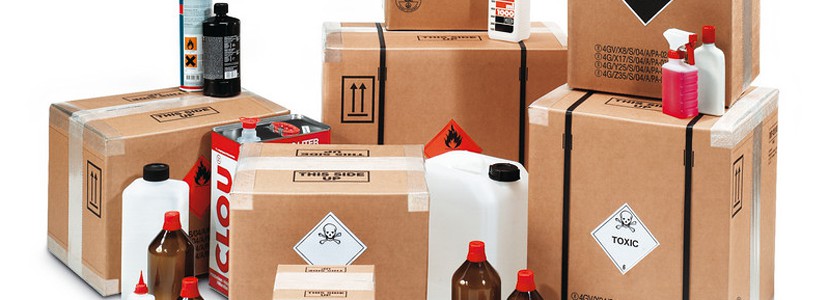How to package: hazardous materials

Often when discussing packaging, the emphasis is on the best solution for keeping the contents of a carton safe from the bumps and knocks likely to be inflicted by those handling it while in transit. But sometimes it needs to protect those handling it from hazards that might be caused by the contents.
Like the good things in life, potentially dangerous substances need to be shipped here, there and everywhere to wherever they are needed. Things that can cause real health hazards should they get spilled, broken, upended and so on, things like acids, solvents, flammable items, corrosives and even radioactive material.
And like those good things, you want to make sure they reach their destinations safely; but with the consequences of a damaged parcel that much higher, the quality and effectiveness of the packaging need to be similarly elevated.
Reducing the risk
When you’re packaging delicate, fragile and valuable items, you naturally want to do all you can to protect them and make sure they reach your customer in one piece. When you’re packaging hazardous goods, you need to take the same approach, but up the amount of protection.
That can mean at the very least stronger boxes. Your strongest option will usually be a plywood case, which has the added benefit of being perfect for export, because as treated wood it is not subject to any restrictions.
You can still use cardboard boxes, but you will want to allow for a stronger box than you usually would for the weight of your product. For example, standard single wall boxes are usually good for up to 10kg, but if the contents are hazardous, make sure you up that to at least double wall.
Similarly, it might also be a good idea to get a bigger box than you might usually do so, to allow for extra internal protective packaging or void fill, which can absorb any blows the box becomes subject to more effectively.
Letting people know about the risk
Labelling is perhaps the most important thing to get right when you’re packaging hazardous substances. After all, if those handling know that any damage caused could be injurious to their own health, they are far more likely to handle the parcel in question with the appropriate care.
However, simple ‘Fragile’ and ‘Handle With Care’ labels are not enough; you need to make sure people handling goods know exactly what it is they are dealing only, not only so they handle it correctly, but so that should an accident happen – and, with the best labelling in the world, accidents can still happen – those on the scene know what the risk is.
Any hazardous item requiring transportation needs to be classified according to existing regulations. There are nine main groups of hazardous substances – explosives, gases, flammable liquid, flammable solids, oxidising substances, toxic substances, radioactive material, corrosive substances and miscellaneous dangerous goods – with various sub-groups covering specific hazards. Each of these has a specific, internationally recognised hazard warning label, and whichever group your product or consignment fits into, needs to display that label prominently on your parcel or load.
Of course, contents can be fatally compromised without the danger being immediately apparent; what, for instance, if a strong plywood box containing a hazardous liquid is dropped from a great height, and the contents leak, but you can’t tell from the outside? The answer might be a ‘Shockwatch’ label; this will automatically turn red or clearly indicate if the parcel has been subjected to a substantial blow (usually measured as being a predetermined g-force rating).
Alternatively, there also labels that will tell you if a load has been tilted beyond a certain angle. In both cases, the label is telling the person receiving the parcel that it needs, at the very least, to be opened with extreme care, if not refused altogether.
Should the worst happen
As mentioned earlier, the best packaging and the best labelling in the world can’t prevent damage from every conceivable incident. Sometimes, hazardous goods leak and spill, or are released into the air.
Good void fill is always a good idea, but if you’re shipping a hazardous liquid, you can use a special variety called vermiculite. It’s a non-flammable natural mineral that can absorb up to four times its weight in liquid, and bind certain liquids, including paint, ink and acids. That means that any spillage that should occur is immediately and safely dealt with.
Outside the immediate concept of packaging, but certainly something to make sure you have available is protective clothing appropriate to the hazard in question. That means that should the worst happen, your staff on the scene will be able to deal with the fallout safely.
Legal requirements
When shipping certain hazardous goods within the EU – the full list can be viewed by clicking here – it must be done with special UN certified packaging. At its heart is a range of boxes, but other products, such as heavy duty polythene box liners, vermiculite void fill and a specific grade of strapping, are also required to ensure compliance when dealing with certain substances. You may also need to use a particular kind of tape applied in a specific place on the carton.
It is worth taking the extra time to check whether your load is likely to require UN approved packaging, as the cost of getting it wrong may well be the loss of your complete load. You can check the full packaging requirement for your load by carefully reading the certification provided by your supplier.
Rick Stanford
Latest posts by Rick Stanford (see all)
- Davpack’s Top Tips for Secure Strapping - 7th September 2022
- The Paper vs Plastic Bubble Wrap Debate - 10th August 2022
- Save Money with Royal Mail Sized Packaging - 8th July 2022
